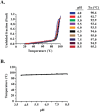Influence of hydrophobic and electrostatic residues on SARS-coronavirus S2 protein stability: insights into mechanisms of general viral fusion and inhibitor design
- PMID: 24519901
- PMCID: PMC4005712
- DOI: 10.1002/pro.2442
Influence of hydrophobic and electrostatic residues on SARS-coronavirus S2 protein stability: insights into mechanisms of general viral fusion and inhibitor design
Abstract
Severe acute respiratory syndrome (SARS) is an acute respiratory disease caused by the SARS-coronavirus (SARS-CoV). SARS-CoV entry is facilitated by the spike protein (S), which consists of an N-terminal domain (S1) responsible for cellular attachment and a C-terminal domain (S2) that mediates viral and host cell membrane fusion. The SARS-CoV S2 is a potential drug target, as peptidomimetics against S2 act as potent fusion inhibitors. In this study, site-directed mutagenesis and thermal stability experiments on electrostatic, hydrophobic, and polar residues to dissect their roles in stabilizing the S2 postfusion conformation was performed. It was shown that unlike the pH-independent retroviral fusion proteins, SARS-CoV S2 is stable over a wide pH range, supporting its ability to fuse at both the plasma membrane and endosome. A comprehensive SARS-CoV S2 analysis showed that specific hydrophobic positions at the C-terminal end of the HR2, rather than electrostatics are critical for fusion protein stabilization. Disruption of the conserved C-terminal hydrophobic residues destabilized the fusion core and reduced the melting temperature by 30°C. The importance of the C-terminal hydrophobic residues led us to identify a 42-residue substructure on the central core that is structurally conserved in all existing CoV S2 fusion proteins (root mean squared deviation=0.4 Å). This is the first study to identify such a conserved substructure and likely represents a common foundation to facilitate viral fusion. We have discussed the role of key residues in the design of fusion inhibitors and the potential of the substructure as a general target for the development of novel therapeutics against CoV infections.
Keywords: MERS-CoV; S2; SARS-CoV; coronavirus; glycoprotein; viral entry; viral fusion.
© 2014 The Protein Society.
Figures






References
-
- Ksiazek TG, Erdman D, Goldsmith CS, Zaki SR, Peret T, Emery S, Tong S, Urbani C, Comer JA, Lim W, Rollin PE, Dowell SF, Ling A, Humphrey CD, Shieh W, Guarner J, Paddock CD, Rota P, Fields B, DeRisi J, Yang J, Cox N, Hughes JM, LeDuc JW, Bellini WJ, Anderson LJ. A novel coronavirus associated with severe acute respiratory syndrome. N Engl J Med. 2003;348:1953–1966. and the SARS Working Group. - PubMed
-
- Rota PA, Oberste MS, Monroe SS, Nix WA, Campagnoli R, Icenogle JP, Peñaranda S, Bankamp B, Maher K, Chen M, Tong S, Tamin A, Lowe L, Frace M, DeRisi JL, Chen Q, Wang D, Erdman DD, Peret TCT, Burns C, Ksiazek TG, Rollin PE, Sanchez A, Liffick S, Holloway B, Limor J, McCaustland K, Olsen-Rasmussen M, Fouchier R, Günther S, Osterhaus ADME, Drosten C, Pallansch MA, Anderson LJ, Bellini WJ. Characterization of a novel coronavirus associated with severe acute respiratory syndrome. Science. 2003;300:1394–1399. - PubMed
-
- Drosten C, Günther S, Preiser W, van der Werf S, Brodt H, Becker S, Rabenau H, Panning M, Kolesnikova L, Fouchier RAM, Berger A, Burguière A, Cinatl J, Eickmann M, Escriou N, Grywna K, Kramme S, Manuguerra J, Müller S, Rickerts V, Stürmer M, Vieth S, Klenk H, Osterhaus ADME, Schmitz H, Doerr HW. Identification of a novel coronavirus in patients with severe acute respiratory syndrome. N Engl J Med. 2003;348:1967–1976. - PubMed
Publication types
MeSH terms
Substances
Associated data
- Actions
- Actions
Grants and funding
LinkOut - more resources
Full Text Sources
Other Literature Sources
Miscellaneous

